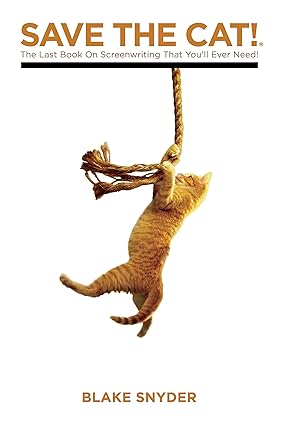FTC Disclosure: Consider each and every link on this site as a commercial relationship or affiliate link, wherein we receive a financial benefit in return for recommending great products we would recommend anyway. Caveat Emptor.
TL;DR: If you want to write stories that sell, grab Save the Cat! and don’t look back. Whether you’re writing movies, novels, or ad copy, this book hands you the blueprint for grabbing people by the eyeballs and not letting go. Buy the dang book. [AMAZON].
You’re here because you want to write something that works. Not some self-indulgent drivel that only your mom and your dog will read, but something that actually sells—whether that’s a screenplay, a novel, a blog post, or even a sales letter. And if you don’t understand what makes a story stick in people’s heads like gum on a hot sidewalk, you’re wasting your time.
That’s where Save the Cat! comes in.
Blake Snyder didn’t just write another “how-to” book filled with fluff about finding your muse or tapping into your inner creative child. No, Save the Cat! is a field manual for writing stories that make people care—and more importantly, pay. It doesn’t matter if you’re cranking out Hollywood scripts, indie novels, or marketing campaigns. The principles in this book are universal, because at the end of the day, all writing is selling. You’re selling an idea, a character, a message, a hook.
And Snyder? He hands you the hook on a silver platter.
He strips storytelling down to its bare essentials—what works, what doesn’t, and why. You’ll learn how to craft characters people root for, plot beats that punch like a prizefighter, and concepts that make publishers, producers, and even jaded readers throw their wallets at you. He’s got a 15-beat structure that’ll make your story practically write itself. And if you think structure kills creativity, guess again. Structure frees you. It gives your story the spine it needs to stand up in a crowded market full of limp, spineless garbage.
Oh, and that “Save the Cat” moment? It’s not just some cute gimmick. It’s the secret sauce that makes people care about your characters. Snyder shows you how to make even the biggest scumbag likable. Because if your audience doesn’t care, you’ve already lost.
Here’s the deal: The marketplace doesn’t reward good intentions or artistic purity. It rewards results. Save the Cat! is about getting those results—whether you’re writing the next Oscar-winning screenplay, a bestselling novel, or the kind of sales copy that pulls in six figures.
So stop thinking about writing better stories. Stop talking about writing better stories.
Read the book.
And for the love of God—use the book.
15 Takeaways From Save The Cat
1. The Title Concept – “Save the Cat” Moment
- Definition: Every protagonist needs a moment early in the story where they do something likable or heroic (metaphorically “saving a cat”) to make the audience root for them.
- Purpose: It helps create empathy, even for flawed characters, and establishes an emotional connection with the audience.
2. The Importance of High-Concept Ideas
- High-Concept Definition: A story idea that is unique, easily pitched in one sentence, and has a clear hook.
- Examples: “A shark terrorizes a small beach town during tourist season” (Jaws).
- Marketability: High-concept stories are easier to sell and attract attention quickly.
3. The Logline Formula
- Components of a Good Logline:
- Irony: Adds a surprising twist that sparks interest.
- A Compelling Mental Picture: Evokes a vivid image in the audience’s mind.
- A Protagonist with a Clear Goal: The main character should be active, not passive.
- Stakes: Clearly defines what’s at risk if the protagonist fails.
4. The 10 Genres of Storytelling (Not Traditional Genres)
Snyder proposes unconventional “genres” based on story structure rather than subject matter:
- Monster in the House – A creature (literal or figurative) threatens a group of people (e.g., Jaws).
- Golden Fleece – A journey to achieve a goal (e.g., The Wizard of Oz).
- Out of the Bottle – Wish-fulfillment stories with a twist (e.g., Liar Liar).
- Dude with a Problem – An ordinary person faces an extraordinary situation (e.g., Die Hard).
- Rites of Passage – Personal transformation through life stages (e.g., Stand by Me).
- Buddy Love – A relationship at the core of the story (e.g., Lethal Weapon).
- Whydunit – A mystery focusing on the why rather than the who (e.g., Chinatown).
- The Fool Triumphant – An underdog or naïve character succeeds against odds (e.g., Forrest Gump).
- Institutionalized – Stories about groups and the sacrifices made to belong (e.g., One Flew Over the Cuckoo’s Nest).
- Superhero – A character with special powers or abilities faces unique challenges (e.g., Spider-Man).
5. The Beat Sheet – 15 Essential Story Beats
Snyder’s signature contribution is his 15-beat structure, outlining key moments every story should hit:
- Opening Image (1%): A snapshot of the protagonist’s world before change.
- Theme Stated (5%): A hint of the story’s central theme, usually in dialogue.
- Set-Up (1-10%): Introduce the main characters, their flaws, and the stakes.
- Catalyst (10%): The inciting incident that disrupts the protagonist’s world.
- Debate (10-20%): The protagonist doubts, resists, or wrestles with the need for change.
- Break into Two (20%): The protagonist commits to the journey; Act Two begins.
- B Story (22%): Introduce a subplot, often a love story or a relationship that mirrors the main plot.
- Fun and Games (20-50%): The “promise of the premise”—where the story delivers what the audience came to see.
- Midpoint (50%): A major event that shifts the story dramatically—either a false victory or false defeat.
- Bad Guys Close In (50-75%): Internal and external pressures mount; things get worse.
- All Is Lost (75%): The lowest point for the protagonist; something symbolic often dies.
- Dark Night of the Soul (75-85%): The protagonist reflects, wallows, and prepares for a comeback.
- Break into Three (85%): The protagonist finds the solution, leading into the final act.
- Finale (85-100%): The climax—problems are solved, the protagonist transforms.
- Final Image (100%): A mirror of the opening image, showing how the protagonist has changed.
6. The Rule of “Double Mumbo Jumbo”
- Avoid Two Unrealistic Elements: Audiences can suspend disbelief for one extraordinary thing (e.g., time travel or magic), but adding more can break the story’s logic.
7. “Pope in the Pool” – Hiding Exposition
- Technique: Deliver exposition in an engaging way by distracting the audience with something visually or dramatically interesting.
- Example: Characters might discuss important plot points while doing something unexpected, like swimming with the Pope.
8. The Importance of a Strong Protagonist with a Clear Arc
- Transformation is Key: The protagonist must grow or change by the end of the story.
- Flaws Drive the Arc: The protagonist starts with a flaw that they must overcome.
9. Stakes Must Be Personal and Universal
- Personal Stakes: The protagonist’s journey should feel urgent and vital to them.
- Universal Stakes: The audience should easily understand and relate to what’s at risk.
10. The Story Must Have a Clear Theme
- Theme as Moral Compass: Every scene should reflect or challenge the central theme.
- Subtle Introduction: The theme is often subtly introduced early on and explored throughout.
11. Every Character Should Serve the Story
- No Extra Baggage: If a character doesn’t serve a specific purpose in advancing the plot or theme, they shouldn’t be in the story.
- Conflict and Contrast: Secondary characters should challenge the protagonist in meaningful ways.
12. The “Law of Averages” – Avoiding Clichés
- Push for Originality: Don’t settle for the first idea that comes to mind; it’s likely the most predictable.
- Twist Expectations: Audiences crave familiar structures but fresh takes.
13. The “Primal” Test
- Tap into Basic Human Emotions: The best stories resonate with fundamental, primal desires and fears—survival, love, revenge, protection of family, etc.
14. Budget and Market Considerations
- Commercial Viability: Snyder emphasizes writing with the market in mind, considering what types of stories are more likely to sell or get produced.
- Budget Awareness: Stories with limited settings or smaller casts are more likely to attract attention from studios due to lower costs.
15. The Importance of Structure in Creativity
- Structure Enhances Creativity: Following a formula doesn’t limit creativity; it provides a framework that ensures the story remains coherent and engaging.
- Stories Without Structure Fail: Audiences subconsciously expect stories to follow certain rhythms and beats.
These principles make Save the Cat! one of the most practical, straightforward guides for storytellers. Snyder’s emphasis on structure, clarity, and emotional resonance helps writers craft stories that are both compelling and commercially viable.






0 Comments